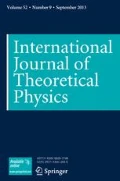Abstract
The Poincaré group is replaced byU(3, 2), the pseudounitary extension of the de Sitter groupSO(3, 2), as internal and space-time symmetries are combined in a geometric setting which invalidates the no-go theorems. A new model of elementary particles as vertical vectors on the principal fiber bundleU(3, 2) →U(3, 2)/U(3, 1)×U(1) is introduced and their interactions via Lie bracket analyzed. The model accounts for the four known superselection rules: spin, electric charge, baryon number, and lepton number.
Similar content being viewed by others
References
Abraham, R., and Marsden, J. (1979).Foundations of Mechanics, 2nd ed., Benjamin, New York.
Barut, A. O. (1980). inSymmetries in Science (B. Gruber and R. S. Milman, eds.,), Plenum Press, New York.
Bohm, A. (1986). Quantum mechanics and spectrum generating groups and supergroups, inSymmetries in Science II (B. Gruber and R. Lenczewski, eds.), Plenum Press, New York.
Burgoyne, N. (1958).Nuovo Cimento,8, 607.
Charon, J. E. (1988).Complex Relativity: Unifying All Four Physical Interactions, Paragon-House, New York.
Coleman, S. (1967). The past of a delusion: Attempts to wed internal and space-time symmetries, inSymmetry Principles and Fundamental Particles (B. Kursunoglu and A. Perlmutter, ed.), Freeman, San Francisco.
Dyson, F. (1966).Symmetry Groups in Particle Physics, Benjamin, New York.
Foldy, L. L., and Wouthuysen, S. A. (1950).Physical Review,78, 29–36.
Fubini, S., Hanson, A. J., and Jackiw, R. (1973).Physical Review D,7, 1732.
Georgi, H. (1982).Lie Algebras in Particle Physics: From Isospin to Unified Theories, Benjamin/ Cummings, Menlo Park, California.
Georgi, H., and Glashow, S. L. (1974).Physics Review Letters,32, 438.
Gunaydin, M., and Saclioglu, C. (1982).Physics Letters,108B, 180.
Halpern, L. (1983). Generalizations of gravitational theory based on group covariance, inGauge Theory and Gravitation (K. Kikkawa, N. Nakanishi, and H. Nariai, eds.), Springer-Verlag, New York.
Hermann, R. (1972).Journal of Mathematical Physics,13, 97.
Hermann, R. (1977). Appendix on quantum mechanics, in R. Nolan Wallach,Symplectic Geometry and Fourier Analysis, MathSci Press.
Hermann, R. (1980). Bohr-Sommerfeld quantization in general relativity and other nonlinear field and particle theories, inQuantum Theory and Gravitation (A. R. Marlow, ed.), Academic Press, New York.
Kaiser, G. (1990).Quantum Physics, Relativity, and Complex Spacetime, North-Holland, Amsterdam.
Kursunoglu, B. (1979). A non-technical history of the generalized theory of gravitation dedicated to the Albert Einstein centennial, inOn the Path of Albert Einstein (B. Kursunoglu, A. Perlmutter, and L. F. Scott, eds.), Plenum Press, New York.
Lipkin, H. J. (1965).Physical Review,139B, 1633.
Love, T. R. (1984).International Journal of Theoretical Physics,23, 801.
Love, T. R. (1987). The geometry of elementary particles, Dissertation, University of California, Santa Cruz, California.
Lurcat, F. (1964).Physics,1, 95–106.
Pais, A. (1986).Inward Bound, Oxford University Press, New York.
Pleblanski, J. (1975).Journal of Mathematical Physics,16, 2395–2402.
Preparata, G. (1979). Quark-geometrodynamics: A new approach to hadrons and their interactions, inThe Ways of Subnuclear Physics (Antonio Zichichi, ed.), Plenum Press, New York.
Rawnsley, J., Schmid, W., and Wolf, J. (1983).Journal of Functional Analysis,51, 1–114.
Rosen, N. (1962).Annals of Physics,19, 165–172.
Roman, P. (1980). Relativistic dynamical groups in quantum theory and some possible applications, inSymmetries in Science (B. Gruber and R. S. Milman, eds.), Plenum Press, New York, p. 327.
Schweber, S. S. (1961).An Introduction to Relativistic Quantum Field Theory, Harper and Row, New York.
Segal, I. E. (1963).Mathematical Problems of Relativistic Physics, American Mathematical Society, Providence, Rhode Island.
Author information
Authors and Affiliations
Rights and permissions
About this article
Cite this article
Love, T.R. Complex geometry, unification, and quantum gravity. I. The geometry of elementary particles. Int J Theor Phys 32, 63–88 (1993). https://doi.org/10.1007/BF00674397
Received:
Issue Date:
DOI: https://doi.org/10.1007/BF00674397




